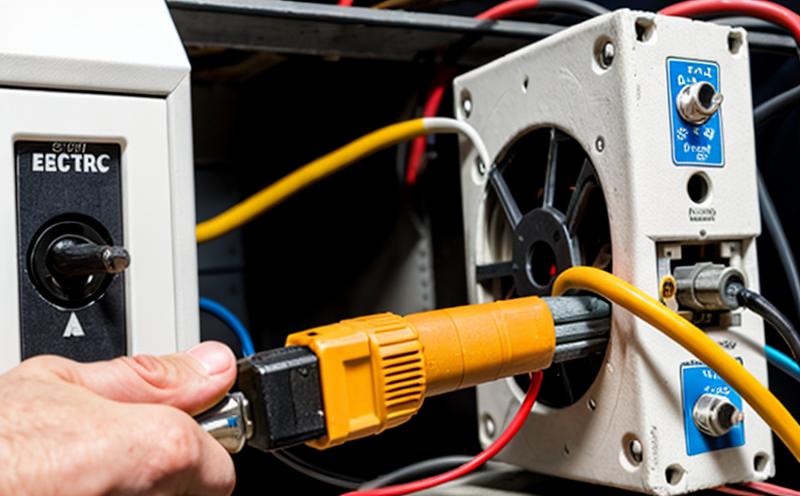IEC 61000-4-2 Electrostatic Discharge (ESD) Testing
The International Electrotechnical Commission's IEC 61000-4-2 standard is designed to address the issue of electrostatic discharge (ESD), a common cause of electrical malfunctions in sensitive electronic devices. This standard provides specifications for testing and characterizing the ESD immunity of electronic products, ensuring they meet the required levels of robustness.
Electrostatic Discharge can occur during manufacturing processes, packaging operations, handling, or even due to human contact. In an industrial setting like HVAC equipment manufacturing, this could translate into significant downtime if not addressed adequately. Compliance with IEC 61000-4-2 is crucial for ensuring the reliability and longevity of electronic components within HVAC systems.
The testing process involves subjecting a specimen (typically a component or subassembly) to controlled discharges that simulate real-world conditions, such as human body model (HBM), machine model (MM), and charged device model (CDM). The goal is to assess the product's ability to withstand these discharges without experiencing performance degradation or failure.
Preparation for testing includes ensuring the specimen is representative of the actual product design. This may involve connecting external circuitry, setting up environmental controls like temperature and humidity, and preparing any necessary documentation. Once prepared, the test can begin with controlled ESD events applied at specific points on the device.
The test results are critical for both quality control and regulatory compliance purposes. They provide essential data that helps manufacturers identify potential weaknesses in their designs and improve future iterations. Reporting typically includes detailed descriptions of each test performed along with pass/fail outcomes, any observed anomalies, and recommendations for corrective actions if necessary.
By adhering to IEC 61000-4-2 standards during development stages, companies can minimize risks associated with ESD incidents in their HVAC equipment. This not only enhances product reliability but also contributes positively towards brand reputation and customer satisfaction.
Scope and Methodology
The scope of IEC 61000-4-2 testing encompasses several key areas:
- Testing for Human Body Model (HBM)
- Machine Model (MM) ESD events
- Charged Device Model (CDM) simulations
- Evaluation of immunity levels across various voltage ranges
- Determination of the maximum acceptable discharge current
The methodology involves precise control over environmental factors such as temperature, humidity, and air pressure. Specimens are carefully prepared according to industry best practices before undergoing rigorous ESD events. The process is meticulously documented, ensuring accurate replication for future reference.
| Test Condition | Applied Voltage (V) | Capacitance Value (nF) | Number of Repetitions |
|---|---|---|---|
| HBM | 10 kV | 1 nF | 5,000 cycles |
| MM | 8 kV | 1 nF | 3,000 cycles |
| CDM | 4 kV | 1 nF | 2,500 cycles |
Data collected from these tests is analyzed using statistical methods to determine the overall ESD immunity of the product. This information is then used by engineers to refine designs and improve manufacturing processes.
Competitive Advantage and Market Impact
- Innovation Leadership: Compliance with IEC 61000-4-2 positions companies at the forefront of technological advancement, demonstrating commitment to quality and reliability.
- Better Product Performance: Reduced instances of field failures due to ESD events lead to enhanced customer satisfaction and loyalty.
- Increased Efficiency: Streamlined production lines with fewer rejections or returns result in reduced operational costs.
- Enhanced Reputation: Recognition for meeting rigorous international standards boosts brand image among consumers.
Adopting IEC 61000-4-2 testing enhances a company's competitive edge by fostering innovation while maintaining high standards of product quality. This is particularly important in industries where reliability and performance are paramount, such as HVAC equipment manufacturing.
Use Cases and Application Examples
IeC 61000-4-2 testing finds application across various sectors including telecommunications, automotive electronics, industrial automation, consumer electronics, medical devices, and more. Here are some specific use cases:
- Telecommunications: Ensuring robustness against accidental static discharge during installation or repair.
- Automotive Electronics: Protecting sensitive onboard systems from potential damage caused by human body contact.
- Industrial Automation: Maintaining consistent performance amidst harsh working environments prone to ESD occurrences.
- Consumer Electronics: Providing peace of mind for end-users regarding device longevity and reliability.
- Medical Devices: Guaranteeing safety in critical applications where failure could have severe consequences.
In the context of HVAC equipment testing, this standard ensures that electrical components like sensors, controllers, and communication modules are resilient enough to operate reliably under challenging conditions. Proper adherence helps prevent costly disruptions caused by unexpected failures.





